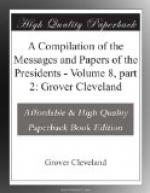To do justice to the subject it is thought proper to show the actual state of the Army before the passage of the late act, the force in service, the several corps of which it was composed, and the grades and number of officers commanding it. By seeing distinctly the body in all its parts on which the law operated, viewing also with a just discrimination the spirit, policy, and positive injunctions of that law with reference to precedents established in a former analogous case, we shall be enabled to ascertain with great precision whether these injunctions have or have not been strictly complied with.
By the act of the 3d of March, 1815, entitled “An act fixing the military peace establishment of the United States,” the whole force in service was reduced to 10,000 men—infantry, artillery, and riflemen—exclusive of the Corps of Engineers, which was retained in its then state. The regiment of light artillery was retained as it had been organized by the act of 3d March, 1814. The infantry was formed into 9 regiments, 1 of which consisted of riflemen. The regiments of light artillery, infantry, riflemen, and Corps of Engineers were commanded each by a colonel, lieutenant-colonel, and the usual battalion and company officers; and the battalions of the corps of artillery, of which there were 8—4 for the Northern and 4 for the Southern division—were commanded by lieutenant-colonels or majors, there being 4 of each grade. There were, therefore, in the Army at the time the late law was passed 12 colonels belonging to those branches of the military establishment. Two major-generals and 4 brigadiers were likewise retained in service by this act; but the staff in several of its branches not being provided for, and being indispensable and the omission inadvertent, proceeding from the circumstances under which the act was passed, being at the close of the session, at which time intelligence of the peace was received, it was provisionally retained by the President, and provided for afterwards by the act of the 24th April, 1816. By this act the Ordnance Department was preserved as it had been organized by the act of February 8, 1815, with 1 colonel, 1 lieutenant-colonel, 2 majors, 10 captains, and 10 first, second, and third lieutenants. One Adjutant and Inspector General of the Army and 2 adjutants-general—1 for the Northern and 1 for the Southern division—were retained. This act provides also for a Paymaster-General, with a suitable number of regimental and battalion paymasters, as a part of the general staff, constituting the military peace establishment; and the Pay Department and every other branch of the staff were subjected to the Rules and Articles of War.




